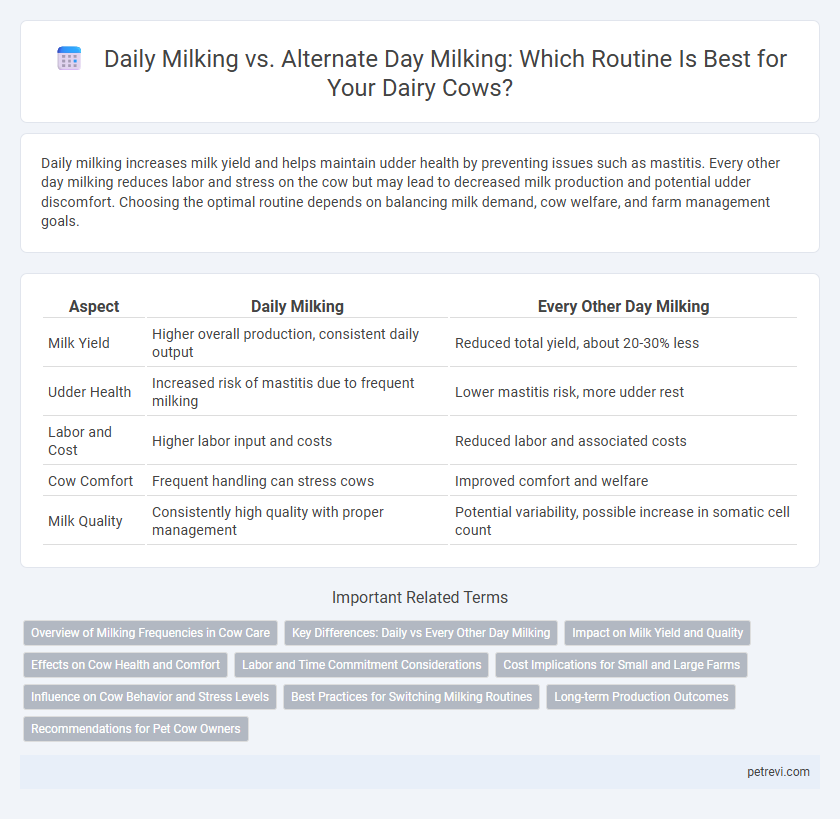Daily milking increases milk yield and helps maintain udder health by preventing issues such as mastitis. Every other day milking reduces labor and stress on the cow but may lead to decreased milk production and potential udder discomfort. Choosing the optimal routine depends on balancing milk demand, cow welfare, and farm management goals.
Table of Comparison
| Aspect | Daily Milking | Every Other Day Milking |
|---|---|---|
| Milk Yield | Higher overall production, consistent daily output | Reduced total yield, about 20-30% less |
| Udder Health | Increased risk of mastitis due to frequent milking | Lower mastitis risk, more udder rest |
| Labor and Cost | Higher labor input and costs | Reduced labor and associated costs |
| Cow Comfort | Frequent handling can stress cows | Improved comfort and welfare |
| Milk Quality | Consistently high quality with proper management | Potential variability, possible increase in somatic cell count |
Overview of Milking Frequencies in Cow Care
Daily milking involves extracting milk from cows every 24 hours, ensuring higher milk yield and maintaining udder health by preventing milk accumulation and reducing the risk of mastitis. Every other day milking reduces labor and feed costs but may lead to decreased milk production and increased udder pressure. Selecting the appropriate milking frequency depends on farm management goals, cow breed, and lactation stage.
Key Differences: Daily vs Every Other Day Milking
Daily milking in cows enhances milk yield by maintaining consistent udder stimulation, reducing the risk of mastitis, and supporting higher lactation performance compared to every other day milking. Every other day milking decreases labor and feed costs but may lead to reduced milk production and increased udder pressure, impacting cow comfort and health. Choosing between routines depends on balancing milk output priorities and herd well-being management strategies.
Impact on Milk Yield and Quality
Daily milking of cows typically results in higher milk yield compared to every other day milking, as frequent milking stimulates increased milk production by maintaining optimal udder emptying and hormonal balance. Milk quality, including fat and protein content, tends to remain stable or slightly improve with daily milking due to consistent udder health management and reduced risk of bacterial growth. Conversely, every other day milking may decrease overall milk volume and potentially affect somatic cell counts, impacting milk quality and shelf life.
Effects on Cow Health and Comfort
Daily milking supports consistent udder health by preventing milk accumulation, reducing the risk of mastitis and discomfort in cows. Every other day milking may increase somatic cell counts and elevate udder pressure, potentially leading to inflammation and stress. Optimal routines balance production demands with animal welfare to maintain comfort and minimize health complications.
Labor and Time Commitment Considerations
Daily milking of dairy cows requires consistent labor input, typically involving two to three sessions per day and demanding significant time commitment from farmworkers. Every other day milking reduces labor hours by approximately 50%, allowing for more flexible scheduling but may slightly impact milk yield and udder health. Farmers must weigh the benefits of decreased labor intensity against potential decreases in production efficiency when choosing the optimal milking routine.
Cost Implications for Small and Large Farms
Daily milking increases milk yield but raises labor and feed costs significantly, impacting small farms' tight budgets more than large-scale operations equipped for efficiency. Every other day milking reduces labor expenses and feed consumption, offering cost savings that can improve profitability for small farms but may slightly decrease output for large farms with high-volume demands. Evaluating farm size and financial flexibility is crucial for optimizing the balance between milk production and operational expenses.
Influence on Cow Behavior and Stress Levels
Daily milking in cows tends to promote a consistent routine, reducing stress and minimizing behavioral disruptions by maintaining regular udder stimulation. In contrast, every other day milking can lead to increased udder pressure and discomfort, potentially causing restlessness and higher cortisol levels indicative of greater stress. Studies show that cows milked daily display calmer behaviors and improved welfare compared to those on extended milking intervals.
Best Practices for Switching Milking Routines
Switching from daily milking to every other day milking requires careful adjustment to prevent mastitis and maintain milk quality by monitoring udder health and hygiene closely. Gradual transition over two weeks allows cows to adapt metabolically, minimizing stress and production dips. Regular record-keeping and consulting with a veterinarian ensures the milking routine meets both animal welfare standards and farm productivity goals.
Long-term Production Outcomes
Daily milking in cows significantly enhances long-term milk production by maintaining consistent udder stimulation, which promotes higher milk yield and better udder health. Every other day milking often leads to reduced total milk output over time and increased risk of mastitis due to irregular milk removal. Consistent daily milking routines support sustained lactation performance and optimal dairy farm profitability.
Recommendations for Pet Cow Owners
Daily milking is recommended for pet cow owners to maintain optimal udder health and consistent milk production, minimizing risks of mastitis and discomfort. Every other day milking can reduce milking time but may lead to increased udder engorgement and lower milk yield, impacting cow well-being. Adhering to daily milking routines supports the natural lactation cycle and promotes a healthier, happier pet cow.
Daily Milking vs Every Other Day Milking for Cow Routine Infographic

 petrevi.com
petrevi.com